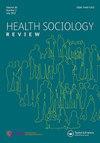康复资本:一种理解北欧福利国家康复的新形式的资本*
IF 2.5
2区 医学
Q2 HEALTH POLICY & SERVICES
引用次数: 13
摘要
与社会、教育和健康相关的平等是北欧福利国家的理想。然而,研究表明,处于有利位置的患者比其他人获得更好的治疗和更多的服务,例如时间和检查。这篇文章探讨了患者和亲属如何在卒中单位的决策调动资源。特别是,它侧重于优化患者和亲属所面临的康复过程的挑战,以及他们使用的策略。数据通过参与观察和半结构化访谈生成。采用定性内容分析对患者及家属的决策经历进行调查。我们提出了一种特定领域的资本形式:在康复领域,个人或家庭的资源被视为身体、行为和认知上的态度和实践。康复资本由四个密切相关的组成部分组成:表演参与(认知嵌入表演和自我发起活动)、身体进步、制度接受和制度潜力。在住院康复期间,它是一种潜在的有利于患者和亲属的资源,可能为患者提供优势,以确保最佳的康复。拥有康复资本(高或低)有助于解释医疗机构微观层面的不平等做法和治疗。本文章由计算机程序翻译,如有差异,请以英文原文为准。
Rehabilitation capital: a new form of capital to understand rehabilitation in a Nordic welfare state*
ABSTRACT Social, educational and health related equality is an ideal in the Nordic welfare states. However studies have shown that well-positioned patients achieve better treatment and more services, for example time and examinations, than others do. This article examines how patients and relatives mobilise resources in decision-making in a stroke unit. In particular, it focuses on the challenges in optimising the rehabilitation process faced by patients and relatives, and the strategies they use. Data were generated using participant observation and semi-structured interviews. Qualitative content analysis was applied to investigate the patients’ and relatives’ experiences of decision-making. We present a field-specific form of capital: An individual or a family's resources that are valued in the field of rehabilitation as physical, behavioural and cognitively embedded attitudes and practices. Rehabilitation capital consists of four closely interrelated components: Performative Participation (Cognitively Embedded Performance and Self-initiating Activities), Bodily Progression, Institutional Acceptance and Institutional Potential. It is a resource potentially benefitting patients and relatives during inpatient rehabilitation and may provide patients with an advantage, to ensure the best rehabilitation. The possession of Rehabilitation capital (high or low) contributes explanations for unequal practices and treatments at a micro-level in healthcare institutions.
求助全文
通过发布文献求助,成功后即可免费获取论文全文。
去求助
来源期刊

Health Sociology Review
Multiple-
CiteScore
7.50
自引率
0.00%
发文量
14
期刊介绍:
An international, scholarly peer-reviewed journal, Health Sociology Review explores the contribution of sociology and sociological research methods to understanding health and illness; to health policy, promotion and practice; and to equity, social justice, social policy and social work. Health Sociology Review is published in association with The Australian Sociological Association (TASA) under the editorship of Eileen Willis. Health Sociology Review publishes original theoretical and research articles, literature reviews, special issues, symposia, commentaries and book reviews.
 求助内容:
求助内容: 应助结果提醒方式:
应助结果提醒方式:


